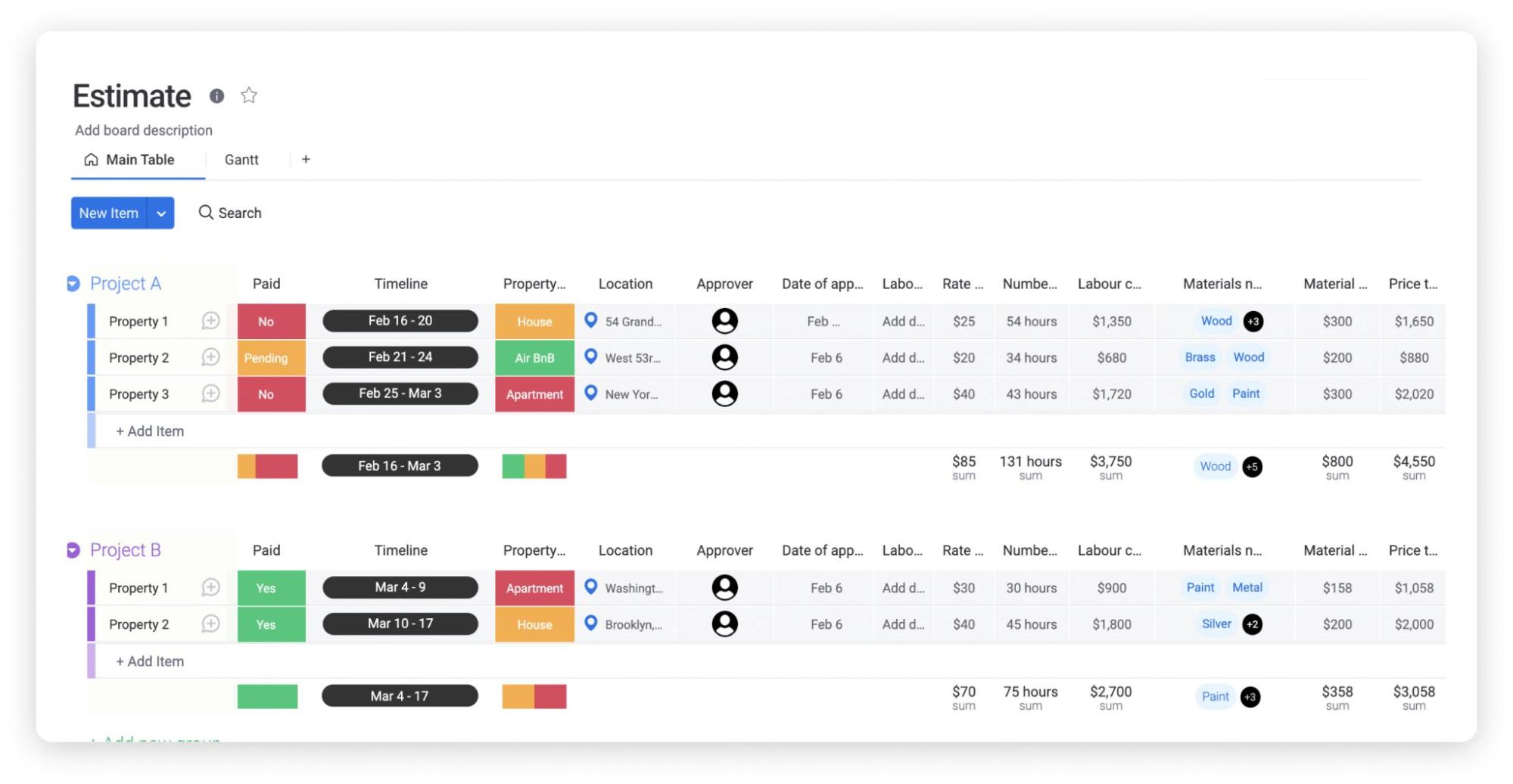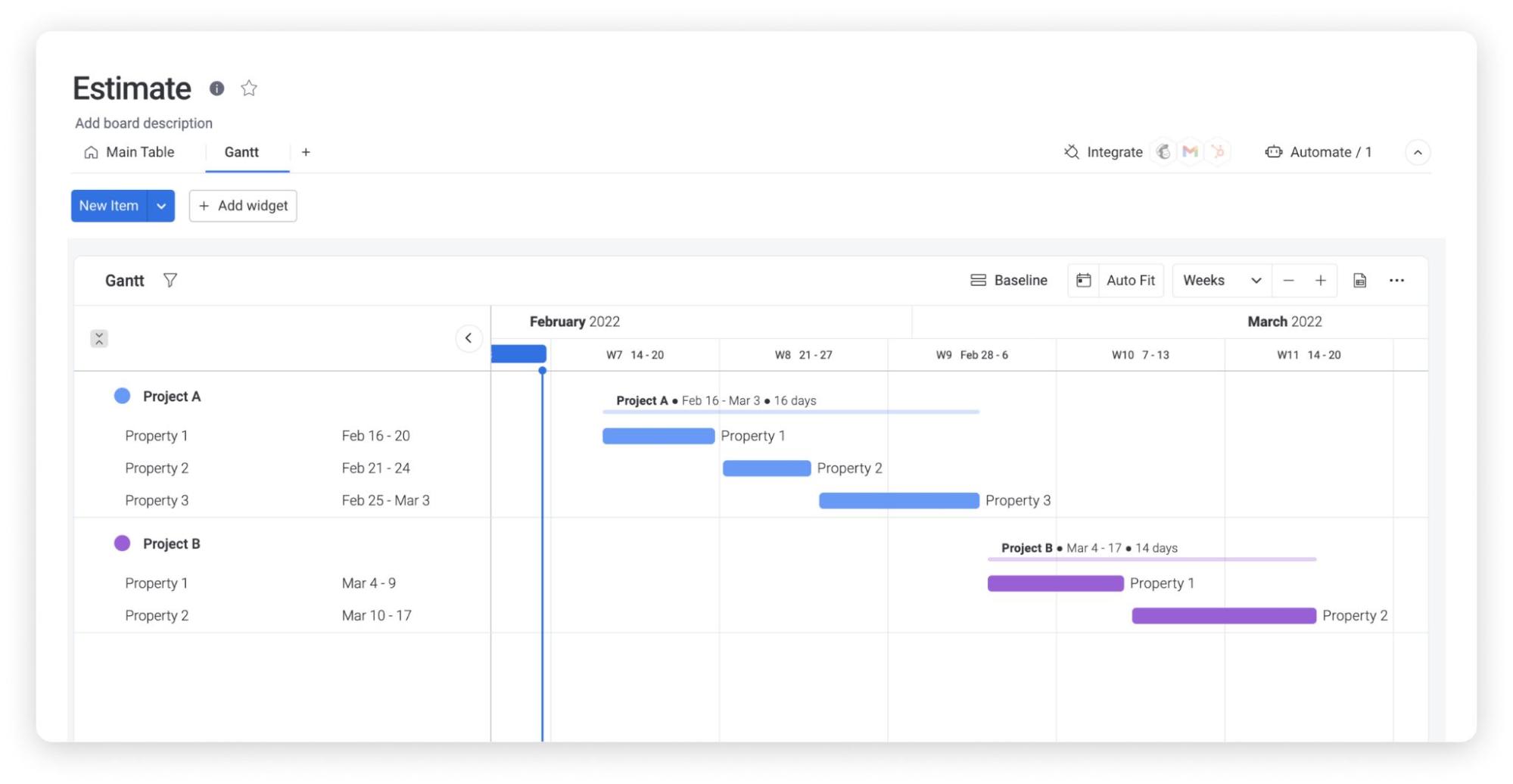Price quotes are an integral part of doing business in many industries. They help communicate pricing estimates to customers in a concise and professional manner. However, they can be pretty time-consuming to put together without a price quote template.
In this article, we’ll walk you through what a price quote template is, how an editable template can speed up workflows. Plus, we’ll share a price quote template built on the monday.com Work OS and show you how our intuitive online workspace can help manage sales quotes and pipelines.
What is a price quote template?
Price quotes are one-page documents where freelancers, contractors, and business owners estimate the costs of their goods or services for a specific need.
Price quote templates are editable, customizable documents businesses can use for estimates.
A price quote template includes all of the information of a standard quote— for example, company contact information—meaning businesses won’t need to re-enter important details for each new quote.

Price estimate templates also include fields for:
- Customer name and contact details
- Itemized costs for goods and services
- Totals
- Tax amounts
- Payment terms and conditions
Some price quote templates also include customer signature lines at the bottom so prospective clients can sign the estimate as proof that they accept the quote. Other than the above benefits, businesses may get substantial value from templates.
Why use a price quote template?
Business owners and entrepreneurs create quotes using templates primarily because it makes the whole process easier. Consider what the typical price quote looks like.

Without a template, a quote requires a table, company logo and contact details, and payment terms for every estimate. And if business is going well, that could be several times a day!
But with a predesigned template on hand, the whole process is a lot more efficient. Businesses can copy the template, leave the original intact for future use, update the quote number, and add the relevant estimate information.
Stay consistent and appear more professional
Aside from the ability to work more efficiently, organizations will also benefit from the consistency and uniformity price quote templates offer. Without a template, repeat customers will receive multiple quotes in different formats and appearances. But standardizing the template for all job estimates helps clients know what to expect and provides a more professional appearance. A professional appearance increases trust from clients, as it shows a company is organized and reliable.
Enough about the benefits, let’s dive into some actual templates.
What are some examples of price quote templates?
Let’s take a look at some examples of price quote templates for different industries and use cases.
Price quote template for construction
Construction companies are a great candidate for price quote templates, as they’re regularly providing estimates to potential clients.
This template includes space to include crucial details that need to be duplicated on every estimate, such as:
- Company name and logo
- Company contact details
- Any terms and conditions regarding payment
Then, each quote needs the customer’s contact details, the quote creation date, and when the quote is valid. Note how the cost of materials is separate from labor in this template. This can effectively help customers understand the specific components that make up the overall estimate.
This price quote template example has fields for start and end dates for the work. Not all quotes require this information, but it can be useful to include it if the project is expected to take place over multiple days, weeks, or months.

Price quote template for vehicle repairs
This one is an example of how automotive repair shops can take advantage of price quote templates. Like the previous template, it includes fields to add your company name and details, which must be included in every quote.
Because this template is specific to the automotive industry, it leaves space for key vehicle details such as registration, odometer reading, and make and model.
Below these details, mechanics can include specific costs and details on whether the automobile needs a repair or a part replacement. Due to the nature of automotive work — it’s sometimes difficult to determine the extent of work required until getting started — this template also includes a clause that states that any figures are based on an initial inspection and don’t constitute a guarantee of the total bill.

monday.com’s price quote template
While there are a lot of helpful free quote templates out there, a lot of them have one problem in common: they’re disconnected from the system that manages and completes the work.
That’s why monday.com Work OS built a powerful, user-friendly template on monday.com workdocs. Here’s how workdocs make quoting easier and smoother:
- Truly collaborative – workdocs makes it easy to work with distributed teams, allowing multiple contributors to edit a single document simultaneously, without disturbing one another.
- Deeply connected – Because workdocs is built on the monday.com Work OS, it’s easy to import data from other monday.com boards — like a sales pipeline — directly into the quote. All of the work you do on monday.com can be seamlessly incorporated into your future work, saving you time having to incorporate it yourself.
- Beautiful visual – Price quote templates look professional, every single time.

Plus, monday.com Work OS has powerful automation rules to manage work efficiently. Once a customer accepts a quote, a manager can add it straight to the task management board, assign it to an employee, and get that work rolling! There are plenty of other ways to get the most out of this template.
Price quote template tips & tricks
But even with a good template, it’s easy for teams to make mistakes without following consistent practices. To help avoid messy accounting, follow the tips below when using price quote templates.
1. Use a quote number system
Make it easy to keep track of quotes by numbering each one in sequential order. Save each new file with the quote number in the title to easily see what the last quote number was without having to open it.
2. Add a quote expiry date
Adding an expiry date to estimates can be a great way to create some urgency and encourage customers to move forward with the work without delay.In some instances, adding quote expiry dates is crucial, as the price of parts of consumables required can change rapidly.
3. Include your payment terms
When using specific payment terms — for example, payment due 20 days after the invoice is issued — it can be helpful to list them in the price quote template. That way, all customers understand your expectations before agreeing to the work.
4. Get clear on any figures that are subject to change
In some cases, it’s not possible to give an exact quote. For example, a mechanic will give a quote based on initial inspection but may require different parts once they start work, which can incur an additional cost. If this kind of situation applies to your industry, add a disclaimer to your price quote template that stipulates that any figures given are estimates and may be subject to change.
5. Schedule a reminder to follow up with the customer
Getting the quote out is only half the battle — now you need to close the deal! Every time you deliver a new quote, schedule an activity in your CRM to call and follow up with the customer within a week.
FAQs about price quote templates
How do you write a price quote?
- Add your company name and contact details at the top of the quote
- Include your customer’s name and contact information
- Add an itemized list of the components of the work, including any labor and parts or consumables required
- Calculate the quote total at the bottom
- Add your payment terms and conditions
Does Microsoft Word have a quote template?
Yes, Microsoft offers a few different quote templates for Word, but they’re often quite basic, and clunky to work with. Not to mention, without smart integrations — like those on monday.com — you have to copy and paste in all the data.
How do you make a quote template?
To create a quote template, create a document with a large table with fields for the following information:
- Your company name and contact details
- Your logo
- Customer name and contact information
- Quote number
- Job details
- Cost for each aspect of the job
- Quote total
- Tax amounts
- Payment terms and conditions
- Quote expiry date
Of course, it’s a lot easier to just download a template and customize it — especially if you want it to look professional.
More templates to love: Sales email template, Email marketing template

